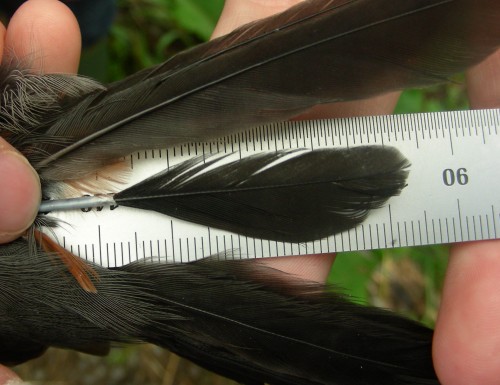|
McGILL BIRD OBSERVATORY |
|||||||||||||||||||||||||||||||||||||||||||||||||||||||||||||||||||||
Welcome
to the McGill Bird Observatory weekly report.
Click here for a complete listing of our archives.
Banders-in-charge: Marie-Anne Hudson, Barbara Frei Assistants: Jean Beaudreault, Sophie Cauchon, Shawn Craik, Jean Demers, Emily Gray, Gay Gruner, Gillian Kinsman, Betsy Mcfarlane, Francine Marcoux, Sarah Marteinson, Chris Murphy, Dan Oyama, André Pelletier, Greg Rand, Katleen Robert, Helena Scheffer, Clémence Soulard Notes: The first week or so of September has traditionally been a somewhat slow period at MBO, and this year was no exception, though the number of birds banded this week was actually slightly higher than week 4 (and a considerable improvement over this year's awfully slow week 3, when only 91 individuals were banded). But while the nets remained fairly quiet, another five species were observed for the first time this fall: Blue-headed Vireo, Cape May Warbler, Northern Parula, American Pipit and Yellow-bellied Flycatcher - most of which had been first recorded quite a bit earlier in the season last year. Four out of these five were actually banded – can you guess which one wasn’t? (Hint: it was seen flying over the fields calling ‘pipit, pipit, pipit'). An additional four new species were banded, bringing our season total to 56, just two behind last year at this time. Other weekly highlights include a first-time recap of the Black-billed Cuckoo banded on Monday, and three species that were banded for the first time this year: Sharp-shinned Hawk, Philadelphia Vireo, and Yellow-bellied Flycatcher. Although the nets were relatively quiet, we know from past experience that activity will soon pick up significantly. So, we took advantage of the relative lull to create some new paths through the increasingly snarled vegetation around Stoneycroft Pond. We can now view a good part of the pond from a little lookout cut out by the D nets. The raccoon tracks in the mud indicate that it’s quite the meeting spot! Another mammal-y highlight has been the Coyotes serenading us with their yips and yowls early in the morning, both from the fields just east of MBO, and from the field to the south of us by the Ecomuseum. Perhaps they’ve made friends with the two young wolves kept there? This week’s top 10 is almost identical to last week’s, with the Magnolia Warbler still leading the pack. This group of species was seen in good numbers at this time last year as well, showing remarkable consistency between years. Though the Blackpoll Warbler is far down the list with just four individuals banded, we wonder whether more are coming considering the number we banded last Spring. For more details regarding the Blackpoll explosion of spring 2007, please check out the season’s end report.
The list of top 10 species observed follows the top 10 banded list, in that there’s very little change from last week. One thing that the table doesn’t show is the number of low-flying raptors in the area. Sharp-shinned and Cooper’s Hawks, among others, have been milling about the site, though seldom getting caught. This marks the beginning of what we hope will be a great season for raptor watching!
|




